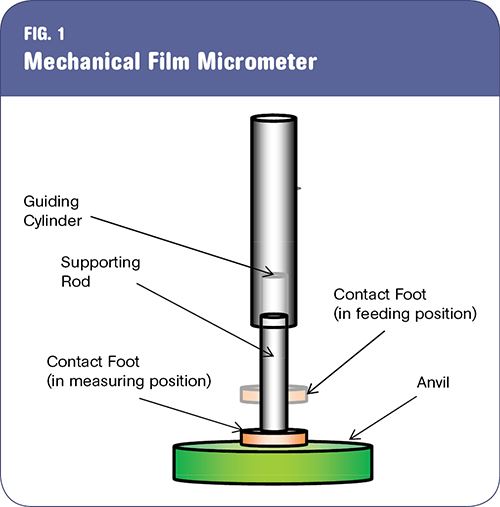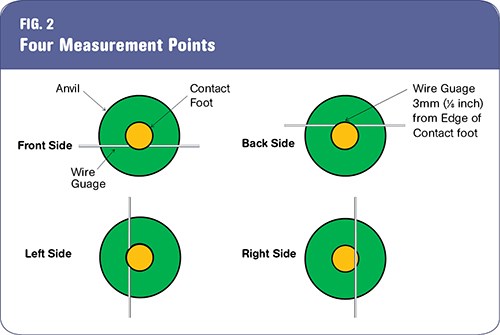Cut Material Waste With Accurate Gauge Measurement
Gauge control done right can save you big money on materials and improve quality to boot.
Almost every film extrusion facility has mechanical devices to measure gauge variation. In many cases, the results differ from one device to the next, making it difficult to ascertain which one is correct. Operators need accurate information during setup to make sure the film gauge is within tolerance. They often overcompensate, making the film too thick in the beginning of a production run, and then adjusting after the first set of rolls is weighed. This strategy reduces yield and profit margins.
A common strategy to compensate for unreliable film gauge micrometers is to estimate the average thickness using the weight of a measured surface area of film (basis-weight technique) or the weight of a roll and core. Accuracy is limited because of possible variations in surface area of the film, concentration of ingredients (especially masterbatches), weight of the core, and length of film on the roll. Assumptions about the density of the various ingredients may be inaccurate. When this strategy is used to estimate average film gauge, mechanical film micrometers are relegated to the task of measuring thickness variation, not average film thickness.
Mechanical film micrometers are constructed with a fixed anvil and a moveable contact foot (see Fig. 1). For film applications, the moveable contact foot usually has a flat surface. There are three common causes for errors: incorrect contact pressure, presence of dirt, and misalignment between the anvil and contact foot.
Simple mechanical film micrometers rely on gravity to apply the correct contact pressure between the anvil and contact foot. More advanced systems use air pressure to do the same thing. Too much contact pressure compresses the film, giving readings that are thinner than the actual film. Operators often pull the film to the next measuring point while the contact foot rests on the film surface. This practice can bend the supporting rod, causing it to stick within the guiding cylinder. This will result in insufficient contact pressure, resulting in thicker-than-actual readings. In extreme cases, the contact foot cannot hold the film in position when it is lowered to the measuring position.
CLEANING & RECALIBRATION
Extrusion and converting facilities are dusty environments. Film-thickness micrometers are precision instruments that can detect the presence of dust and provide inconsistent measurements. Operators often resort to measuring the same point two or three times, a technique known as “stamping,” to obtain consistent thickness readings. This takes extra time and can compress the film, resulting in thinner-than-actual readings.
To clean the measuring surfaces, insert a piece of paper between the anvil and the contact foot. Then allow the contact foot to press the paper against the anvil, as if to measure the paper thickness. Pull the paper slowly about 5 cm (2 in.) while the contact foot is in the measuring position. Raise the contact foot and remove the paper. Bring the contact foot into contact with the anvil and recalibrate the micrometer to display zero thickness. Test the accuracy by raising and lowering the contact foot three or four times.
Measurement results should be between 0 and ±1 micron (±0.04 mils). If results vary more than this amount, try cleaning the measuring surfaces with a cotton swab soaked in alcohol and repeat the recalibration procedure. If measurement error persists, perform the parallelism procedure described in the next section.
PARALLEISM TEST & ADJUSTMENT
The anvil and flat surface of the contact foot must be parallel to within 1 micron (0.04 mils) to maintain accurate resolution for most mechanical micrometers. A parallelism wire gauge of 0.25 to 0.50 mm (0.01 to 0.02 in.) diam. is required for this test. If the instrument has a digital display, turn it on and wait at least 30 minutes for it to warm up before you begin.
Place the wire gauge on the anvil and lower the contact foot using standard pressure. The distance from the outside edge of the contact foot to the wire gauge should be no more than 3 mm (1/8 in.). Compare the measurements in all four positions as shown in Fig. 2. The film micrometer must be adjusted if the difference between opposite sides (front vs. back, left vs. right) is more than 1 micron (0.04 mils).
Some film micrometers have anvils that can be accurately repositioned. Another option is to use very fine sandpaper to make the measuring surface of the contact foot parallel to the anvil. This technique is known as lapping. Bent supporting rods cannot be repaired and must be replaced.
One point of view is that accurate measurement of film-gauge variations is not important because gauge variation cannot be eliminated, only tolerated. Companies that follow this strategy are doomed to low margins because they give away raw material.
Related Content
Troubleshooting Screw and Barrel Wear in Extrusion
Extruder screws and barrels will wear over time. If you are seeing a reduction in specific rate and higher discharge temperatures, wear is the likely culprit.
Read MoreHow Screw Design Can Boost Output of Single-Screw Extruders
Optimizing screw design for a lower discharge temperature has been shown to significantly increase output rate.
Read MoreRoll Cooling: Understand the Three Heat-Transfer Processes
Designing cooling rolls is complex, tedious and requires a lot of inputs. Getting it wrong may have a dramatic impact on productivity.
Read MoreHow to Select the Right Cooling Stack for Sheet
First, remember there is no universal cooling-roll stack. And be sure to take into account the specific heat of the polymer you are processing.
Read MoreRead Next
See Recyclers Close the Loop on Trade Show Production Scrap at NPE2024
A collaboration between show organizer PLASTICS, recycler CPR and size reduction experts WEIMA and Conair recovered and recycled all production scrap at NPE2024.
Read MoreMaking the Circular Economy a Reality
Driven by brand owner demands and new worldwide legislation, the entire supply chain is working toward the shift to circularity, with some evidence the circular economy has already begun.
Read MoreLead the Conversation, Change the Conversation
Coverage of single-use plastics can be both misleading and demoralizing. Here are 10 tips for changing the perception of the plastics industry at your company and in your community.
Read More























